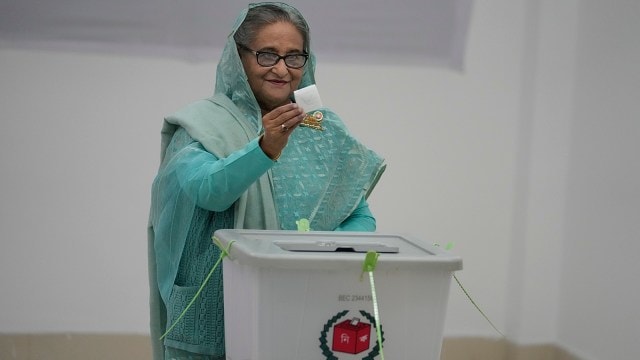
South Asian politics has been shaped by family dynasties, from the Nehru clan in India to the Sheikh family in Bangladesh, from the Bhuttos in Pakistan to the Rajapaksas in Sri Lanka. In most cases, they have relied on legacies and centralised authority. Indira Gandhi and Sheikh Hasina were two rulers empowered by their fathers’ political legacies.
Indira Gandhi was a leader of global stature and one of the most powerful women leaders of her time. Widely recognised for her influence on both national and international stages, she was ranked as the ninth-most powerful woman of the 20th century by Time magazine. Nicknamed the “Iron Lady,” Indira Gandhi came to power when India was reeling from food crises and political instability. Her ambitious reforms, the Green Revolution, bank nationalisation and strong foreign policy positioning during the Cold War defined her as a decisive leader.
Sheikh Hasina focused on growth and development, often promoting large infrastructure projects and steady economic progress as signs of national advancement. Bangladesh’s GDP per capita rose from about $800 in 2009 to over $2,800 in 2023, positioning it among the fastest-growing economies in Asia. Combating religious extremism, militancy and terrorism, most visibly during the 2016 Holey Artisan Bakery attack — which restored a sense of security and curbed large-scale extremist violence in the years that followed. However, her heavy-handed approach extended beyond counterterrorism and led to democratic backsliding, the suppression of political opposition, widespread corruption, and the muzzling of the press. Hasina’s eventual exit has left Bangladesh at a crossroads between an authoritarian relapse and democratic renewal.
Both Indira Gandhi and Hasina faced political upheavals that tested the limits of their authority. Their domineering styles ultimately shaped not only their legacies but also their fates. During the Emergency in 1975 and the 2024 Monsoon Revolution, Gandhi and Hasina, respectively, responded with repression, convinced that state force would silence dissent and secure their hold on power. Yet, in the aftermath, their paths diverged in vastly different directions.
In 1975, civil liberties were suspended, the press was censored, and thousands of political opponents were put behind bars in India when Indira Gandhi declared the Emergency.
For nearly two years, the state enforced her will. Over 1,00,000 people were arrested, including prominent political opponents, journalists, and dissenters. 34,988 people were arrested under the Maintenance of Internal Security Act and 75,818 under the Defence of India Rules.
Despite her suppressive rule, Indira Gandhi eventually lifted the Emergency in 1977 and held free and fair elections, where she lost both her government and her own parliamentary seat. Her government followed democratic principles and “accepted the verdict of the people with complete humility.” Shortly after, on January 24, 1978, she publicly acknowledged that she had committed mistakes during the Emergency. For many, this humiliation seemed like the closing of her political career. History would prove otherwise.
In contrast, Sheikh Hasina oversaw three controversial and largely non-participative elections in 2014, 2018, and 2023, mostly boycotted by the opposition with widespread allegations of rigging. She openly bragged about wanting “absolute power,” and her suppression of democratic rights and dissent fuelled public anger towards more than a decade-and-a-half of iron-fisted rule. Hasina’s ousting was the inevitable consequence of extrajudicial killings, forced disappearances, and imprisonment through the Digital Security Act, which had placed her in an authoritarian frame.
Even a leader of Indira Gandhi’s stature, who ruled India with a firm hand, was humble enough to apologise when she had erred. Besides contrition, she spent three years in opposition as she focused on reflection and left room for the electorate to reimagine her return. That acknowledgment reflected a recognition that political authority is not above accountability. Indira Gandhi vowed to take the “entire responsibility” for the mistakes and excesses of the Emergency rule, even if others would not own them. Her willingness to admit mistakes restored the public’s respect as, in 1980, voters welcomed her return to power.
In contrast, to this day, even after being forced to flee the country, Sheikh Hasina has shown very little remorse and has not offered any apology despite the deaths, injuries, suffering, and widespread unrest under her watch. She tried in vain to divert attention to the damage caused by protesters and resorted to brutal suppression that resulted in at least 1,400 deaths and more than 20,000 injuries. When Hasina intensified repression, she compressed the demise of her power into a few weeks. Had she understood better how a leader’s conduct in a crisis can shift the balance of power, things could have been different. Her departure on August 5, 2024, following weeks of escalating protests, marked the end of one of South Asia’s longest uninterrupted civilian rules.
History teaches that those who know when to bow may rise again, and those who refuse are swept away by the very people who elected them in the first place. Indira Gandhi’s eventual redemption stemmed not from her power but from her humility. For Sheikh Hasina, and in fact for her political allies and followers as well, the lesson is clear: Accountability and humility are not weaknesses but the essence of true leadership and political sagacity.
The writer is Senior Director of the international think tank IPAG India, with a presence in Dhaka, Melbourne, Dubai and Vienna